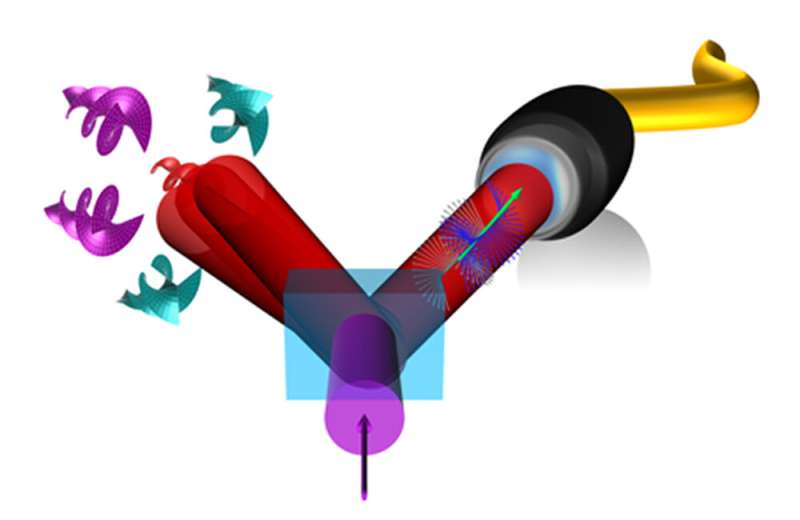A new twist on quantum communication in fiber

New research done at the University of the Witwatersrand in Johannesburg, South Africa, and Huazhang University of Science and Technology in Wuhan, China, has exciting implications for secure data transfer across optical fiber networks. The team have demonstrated that multiple quantum patterns of twisted light can be transmitted across a conventional fiber link that, paradoxically, supports only one pattern. The implication is a new approach to realizing a future quantum network, harnessing multiple dimensions of entangled quantum light.
Science Advances published the research by a team led by Professor Andrew Forbes from the School of Physics at Wits University in collaboration with a team lead by Professor Jian Wang at HUST. In their paper, titled "Multi-dimensional entanglement transport through single mode fiber," the researchers demonstrate a new paradigm for realizing a future quantum network. The team showed that multiple patterns of light are accessible after a communication link of conventional optical fiber that paradoxically can only support a single pattern. The team achieved this quantum trick by engineering entanglement in two degrees of freedom of light, polarization and pattern, passing the polarized photon down the fiber and accessing the many patterns with the other photon.
"In essence, the research introduces the concept of communicating across legacy fiber networks with multi-dimensional entangled states, bringing together the benefits of existing quantum communication with polarized photons with that of high-dimension communication using patterns of light," says Forbes.
A new twist, a new paradigm
Present communication systems are very fast, but not fundamentally secure. To make them secure researchers use the laws of nature for encoding by exploiting the quirky properties of the quantum world, such as in the case of the use of quantum key distribution (QKD) for secure communication.
"Quantum" here refers to the "spooky action at a distance" so abhorred by Einstein: quantum entanglement. In the last few decades, quantum entanglement has been extensively explored for a variety of quantum information protocols, notably making communication more secure through QKD. Using so-called "qubits" (2-D quantum states), the information capacity is limited, but it is easy to achieve such states across fiber links using polarization as a degree of freedom for the encoding. The spatial pattern of light, its pattern, is another degree of freedom that has the benefit of high-dimensional encoding. There are many patterns to use, but unfortunately, this requires custom fiber optical cable and is therefore unsuitable for existing networks. In the present work, the team has found a new way to balance these two extremes by combining polarization qubits with high-dimensional spatial modes to create multi-dimensional hybrid quantum states.
"The trick was to twist the one photon in polarization and twist the other in pattern, forming 'spirally light' that is entangled in two degrees of freedom," says Forbes. "Since the polarization-entangled photon has only one pattern, it could be sent down the long-distance single-mode fiber (SMF), while the twisted light photon could be measured without the fiber, accessing multi-dimensional twisted patterns in the free space. These twists carry orbital angular momentum (OAM), a promising candidate for encoding information."
Overcoming the present challenges
Quantum communication with high-dimensional spatial modes (for example, OAM modes) is promising, but only possible in specially designed multi-mode fiber, which, however, is greatly limited by mode (pattern) coupling noise. Single-mode fiber is free of this "pattern coupling" (which degrades entanglement) but can only be used for two-dimensional polarization entanglement.
"The novelty in the published work is the demonstration of multi-dimensional entanglement transport in conventional single-mode fiber. The light is twisted in two degrees of freedom: the polarization is twisted to form spirally light, and so is the pattern. This is referred to as spin-orbit coupling, here exploited for quantum communication," says Forbes. "Each transmission is still only a qubit (2-D) but there are an infinite number of them because of the infinite number of twisted patterns we could entangle in the other photon."
The team demonstrated transfer of multi-dimensional entanglement states over 250 m of single-mode fiber, showing that an infinite number of two-dimensional subspaces could be realized. Each subspace could be used for sending information, or multiplexing information to multiple receivers.
"A consequence of this new approach is that the entire high-dimensional OAM Hilbert space can be accessed, but two dimensions at a time. In some sense it is a compromise between simple 2-D approaches and true high-dimensional approaches," says Forbes. Importantly, high-dimensional states are unsuitable for transmission over conventional fiber networks, whereas this new approach allows legacy networks to be used.
More information: J. Liu el al., "Multidimensional entanglement transport through single-mode fiber," Science Advances (2020). advances.sciencemag.org/content/6/4/eaay0837
Journal information: Science Advances
Provided by Wits University





















